To our surprise, we discovered that the tiny wind blasted cubicle still stood as we clambered up to the prominent peak at nearly 10,000 feet. We had left all forest vegetation behind us several hundred vertical feet back on our climb. This weathered and decomposing shed was in the alpine tundra zone, that area of perpetual permafrost and rock where few plants or animals could bear the elements borne by the incessant tumultuous weather that defined the environment there.
It was an elfin shack, only 6 by 6 feet, made of rough cut Douglas-fir dimension wood. A few cables lay strewn across the granitic summit dome of Taylor Mountain; they were the only reason, along with the stacked rock wall that it had stood firm through ice and gale for almost 100 years. My tall frame hardly fit in the door and through the decrepit doorway. But once I got in there, as I peered through the window holes, and stepped on the fragmented glass on the broken floorboards, the setting was enough to transport me back in time, 80 years prior, to the heyday of fire lookouts like this one.
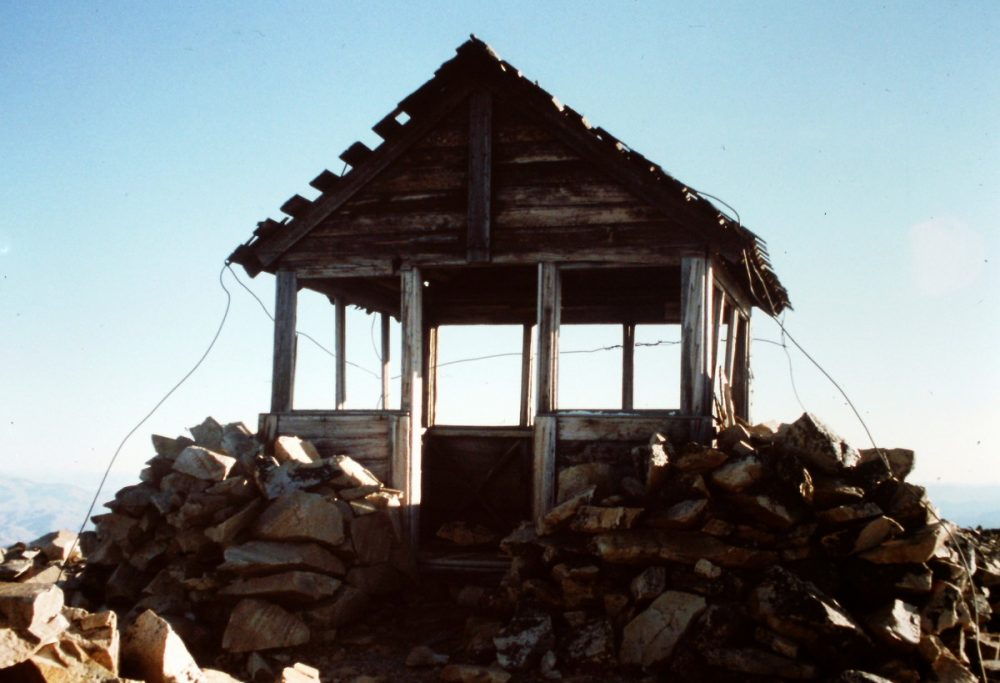
July 21, 1944. After a rousing breakfast of hotcakes and salt pork in your tiny log shack below timberline, you know it is time to make the climb for Taylor’s summit dome. Under cloudless blue skies, you know it will be unusually hot and still on the peak on this balmy afternoon. Droughty conditions add to the concern of fire danger, and you begin a scan of the forested horizons all around you for telltale signs of lightning caused smokes from yesterday’s lightning bust. With your cumbersome field glasses, you look even more intently as you stop for breathers while clambering over the big rock granite boulders on the way up. A pika, tiny rabbit cousin denizen of alpine rock gardens, scolds at you with his desperate peenting bark as he stores and harvests grass hay for the upcoming winter.
You arrive at the 6 x 6 shack at the summit in time for the 9 AM check-in. You pick up the black handset off of the wooden phone box on the wall. A handcrank on the side rings a bell on the single copper wire that snakes through 45 miles of forest (attached to live trees) and rangeland to the Salmon, Idaho ranger station. One other fire lookout, on Lake Mountain, about 20 miles to the north, shares your line. On your home of Taylor, you are offered a panoramic view of most of the southern portion of the vast Salmon National forest.
On the short phone call, you hear news that Marines have landed on Guam in the Pacific theater of World War II. You are most likely one of the following: a very young man (as young as 16 years old), an older man, or a woman. In this year all able bodied men have been recruited for war service, dispatched to either European or Pacific fronts.
Speaking of the war effort, you are reminded on the call by the District Ranger himself to watch for balloon bombs. Nearly 300 of these would be discovered on US soil, and 9300 were launched by the Japanese armed forces on the island of Honshu during the latter part of the war. They were hydrogen balloons placed in the jet stream to hitchhike for a quick trip across the broad Pacific. The idea was that suspended bombs were intended to ignite forest fires and incite terror. Few civilians knew of the balloon bombs due to a concerted cover-up effort by the US government to keep the populace calm.
Only 5 known casualties were caused by them over the entire war; most of the balloons landed in remote areas in Idaho and Oregon, but a few drifted as far east as Iowa and Texas. Several were shot down by military recon fliers. In the end, all failed to ignite forest fires of any consequence (one dud was discovered in a remote forest location in British Columbia as late as 2014).
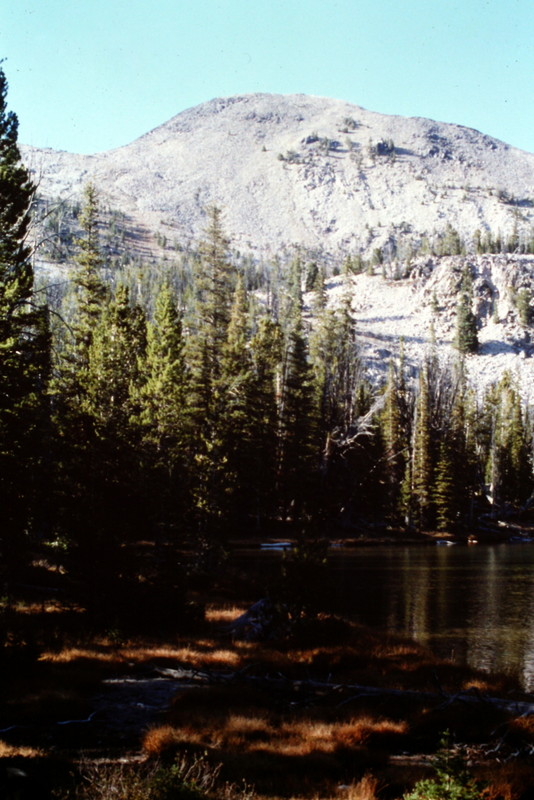
You hang up the phone. It is your only contact with the outside world. There are no radios for most lookouts, and since yours has a telephone (albeit primitive) there is nothing else. Since that single copper wire is nailed to green trees, down trees wiping out the line is common. Many fire lookouts just returned the heliograph, a morse code mechanism of mirrors that could be used to reflect sunlight to other observers. These had problems, however; first, the sun needed to be shining, and second, the operator had to be fluent in the dot dash of morse code.
You step outside the 36 square foot cubicle and gaze to the west. As an insult to injury of already dry forests, afternoon clouds condense into cumulonimbus heights, with icy anvil shaped clouds stretching across the stratosphere at 40,000 feet. As a fire lookout, you know that this vertical development signals danger, and it means inevitable lightning. Such days are more the norm than not in Idaho high summer.
All is quiet for now, except the buzzing of an occasional fly in the afternoon warmth. Even the almost incessant breeze has abated, but the onward march of the great storm cells begin to cast great shadows across the limitless forests that fill the western vista.
You can spot the skeletal trees 19 miles to the west that outline the Wilson Creek fire. Its 13,000 acres are the current 2nd place holder for forest fire size on the forest. It was spotted from this lookout in 1929, for good reason; Taylor is the second highest lookout on the Salmon Forest.
The first place holder for fire size burned in 1910. The great fire of 1910 was fresh in the memory of many still alive in this era of the 40s; it burned a 50 mile wide swath that went from Salmon, Idaho to Canada, and claimed 85 lives and many more over time due to burns and smoke inhalation. It forced the formation of the Forest Service as a legitimate fire security organization, and created the elaborate lookout network that dotted forest maps by the 1930s.
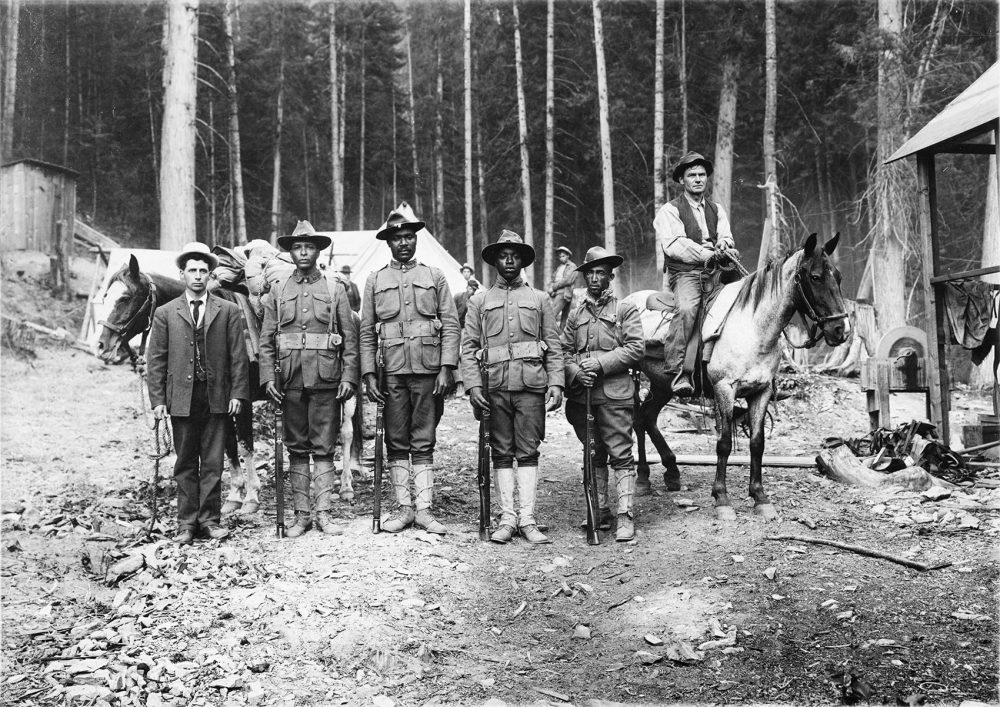
The storm cells continue their march toward your position from the western horizon. One in particular is coming fast, and Taylor looks to be directly in its path. In just another hour, the lookout is blasted by icy downdrafts cascading frigid air from over 40,000 feet. You spin reflexively on your heel, and quickly book it back into the shack. A blinding flash accompanied by a nearly simultaneous blast of thunder beats you through the door, helping you on your way.
Without a thought, you sit obediently on the 4 legged stool next to the tabled fire finding instrument in the middle of the tiny room. It’s called an alidade, and it is a cross between a huge compass and surveying instrument. Its flat and circular horizontal surface is a detailed map of the 100 square miles of Forest that Taylor Mountain is right in the middle of. With that tool, you have been trained to locate fires with precision accuracy given a sighting by another lookout to “cross azimuth” the two positions, yielding razor sharp pinpointing of fire locations. It is the primary objective of fire lookouts, to allow location information for direct and immediate fire attack while fires are small.
As you watch the rapidly approaching cell vaunting the way up from the Morgan Creek drainage to the west, you check your legs and arms to ensure that you are touching nothing. Your feet are safely up on the rungs below your rounded seat. It’s the only way you’ll be safe from a lightning strike that may even find a way into your shack—inverted glass telegraph insulators on your chair legs provide insulation from any stray voltage that your lookout may receive. Heavy copper wires anchored to the rocks around the shack should carry most of it from the lightning rod at the roof apex to the ground, but in case they don’t you don’t want your body to complete any circuits.
If your body would complete the circuit, it would be the last thing you do. So you keep your legs up off the floor, on the rungs of the stool.
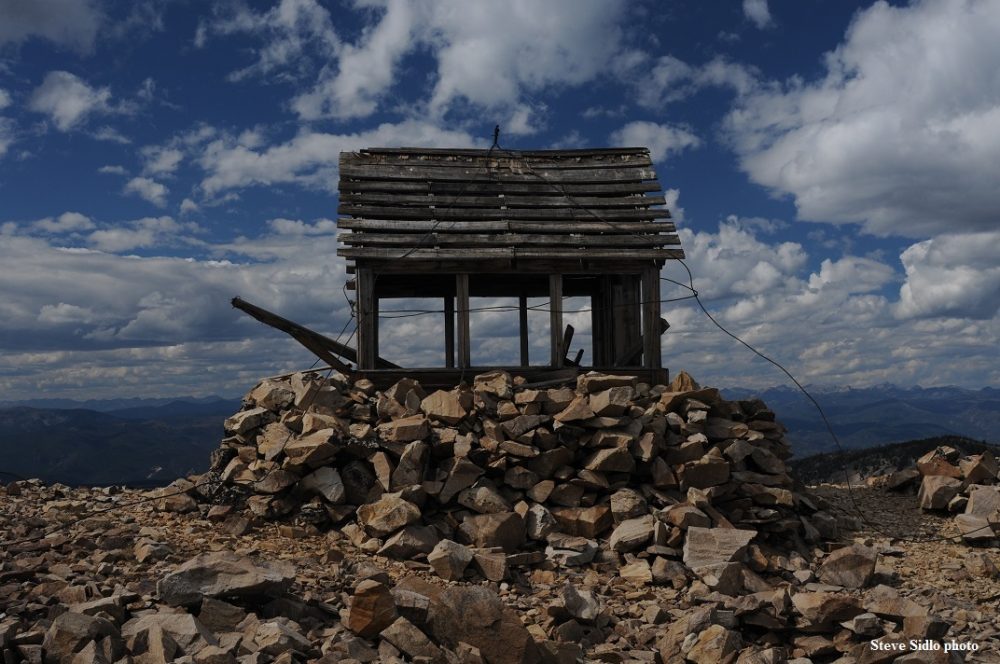
“And you don’t touch anything. Nothing. Especially anything made of metal,” says Janet Bloemeke, long time friend of ours and longer time fire lookout. Janet is in the top ten of the longest serving fire lookouts in the history of the Forest Service. She manned—or womanned—fire lookouts throughout the West for over 35 years.
I called Janet today to get an idea of what it was like when her primary lookout station, Long Tom Lookout, was enveloped by a storm cell.
“Many lookouts are high enough that when the cell hits you, the bottom of the cloud is actually quite a ways below you.” She went on to say describe that you were actually enveloped by the storm cell, and find yourself in the dim and gray light of dense fog all around you. Winds can shake the building and feel as if it will be ripped asunder. Driving rain, snow (even in July) and hail rattle the roof—and your bones.
“That’s when the adrenaline really gets pumping.” She paused as she recalled the experience in her mind’s eye. “You are on your barstool—the one with the glass feet—and your hair stands on end from the incredible static electricity in the air.”
And then, lightning pounds incessantly. Janet recounts: “Horizontal bolts of lightning flash across the air immediately in front of you with simultaneous thundering. It’s incredible.”
She went on to describe the blue blinding flashes of lightning bolts within not miles, but feet.
I’ve once spoken to a lookout who experienced St. Elmo’s fire—that mysterious, blue orb-like glow that occupies prominences in and around the lookout cabin. It is indeed real, although there are various theories of exactly what is happening. Some say it is similar to what happens in a fluorescent light—charged particles create ionization in the gases of nitrogen and oxygen—and emanate a mysterious blue light accompanied by a buzzing.
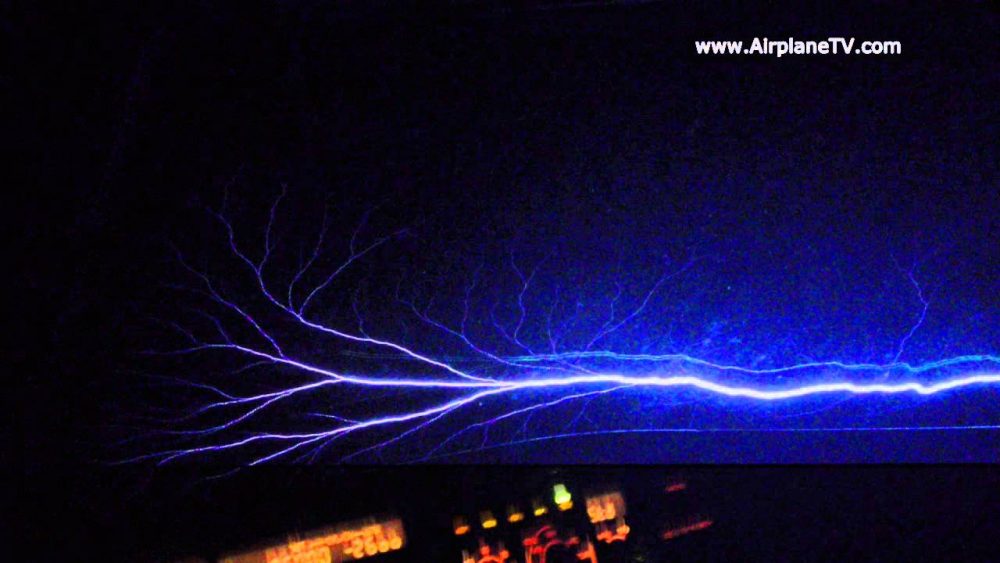
Quite unnerving, they said.
Then, in an extremely rare situation, ball lightning is said to have rolled into lookouts. Ball lightning can pass through solid surfaces like glass, and usually is brightly glowing orb a foot or so in diameter. It can bounce, roll and float through lookouts, houses and ships at sea. It has killed people, especially if they are connected to a ground. Science still leaves ball lightning in the unexplained category, and there is much debate to its composition and origin. It is certainly real, but unfortunately very ephemeral and unpredictable by nature.
And that makes it difficult to study. And that—the unknown—makes it beautiful and terrible at the same time.
Reverie ended and reality resumed, I look out across the vast sea of timber cloaked swells to the west. These are the Salmon River Mountains. They roll, crest and pitch all the way over 100 miles to Oregon from where I stand in the rickety lookout shack. I step across the broken floor (the alidade is long gone from its place in the middle of the room) and look to the East. The country pitches steeply downward, 6000 feet to the Salmon River. In that cascading drop, I know are Alderspring beeves, grazing the big country that they live in for the summer.
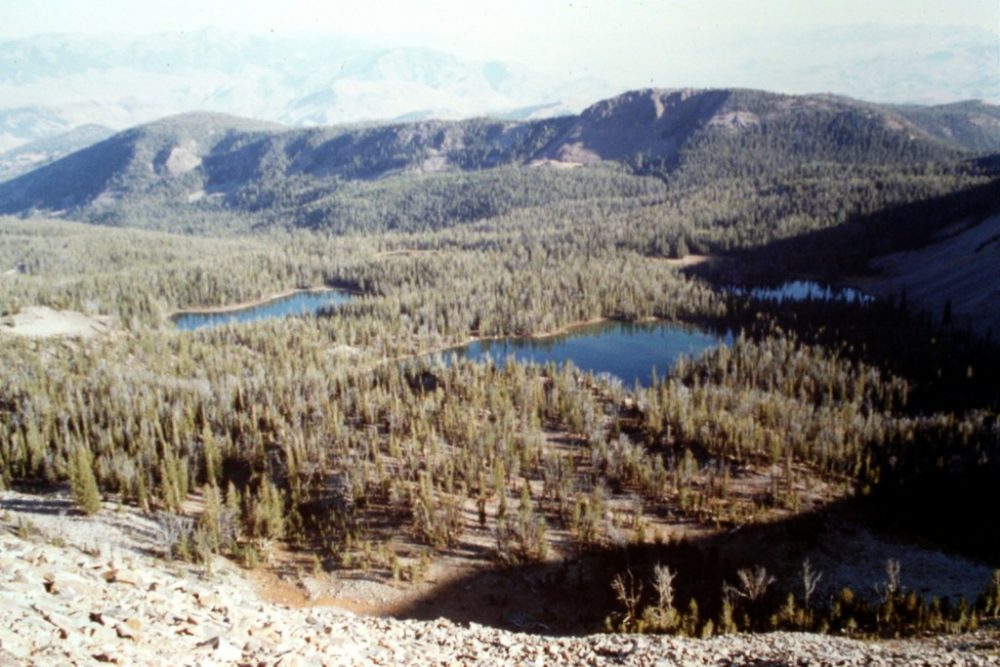
Taylor Mountain is the very highest point on our grazing range. Technically, we could graze cattle right up to the foot of the peak, but we don’t. Instead, we leave it to the wild high country residents. There are the white and sure footed mountain goats, wolves and wolverines. There are occasional moose, multitudes of elk and black bears. There are abundant trout in the Hat Creek Lakes at the base of Taylor.
It’s a refuge of sorts, and not really a place for our cattle, due to the sensitivity of these alpine environs.
So we leave it alone, and graze it not. It’s true wilderness up there, made complete by the abandonment of a fire lookout on this difficult to access peak in 1956.
Lookouts have almost all been abandoned with the advent of ubiquitous aviation reconnaissance for fire. People like Janet still live to share their adventures of life up there on the edge of violent, raw and wild storm power, but not for long. In just a few years, lookouts will be a memory, and nature will slowly, inexorably reclaim those buildings, phone lines and trails for its own.
And that is OK. I think the best progress we can make in these landscapes is to let our footprints be erased by a wild and unpredictable nature, and to aid and abet that whenever possible.
And so we’ll continue to graze in the same way—ideally to leave no trace that we’ve been there. And to mimic and join nature in her ways, letting her take her course. It’s the best way, I think.
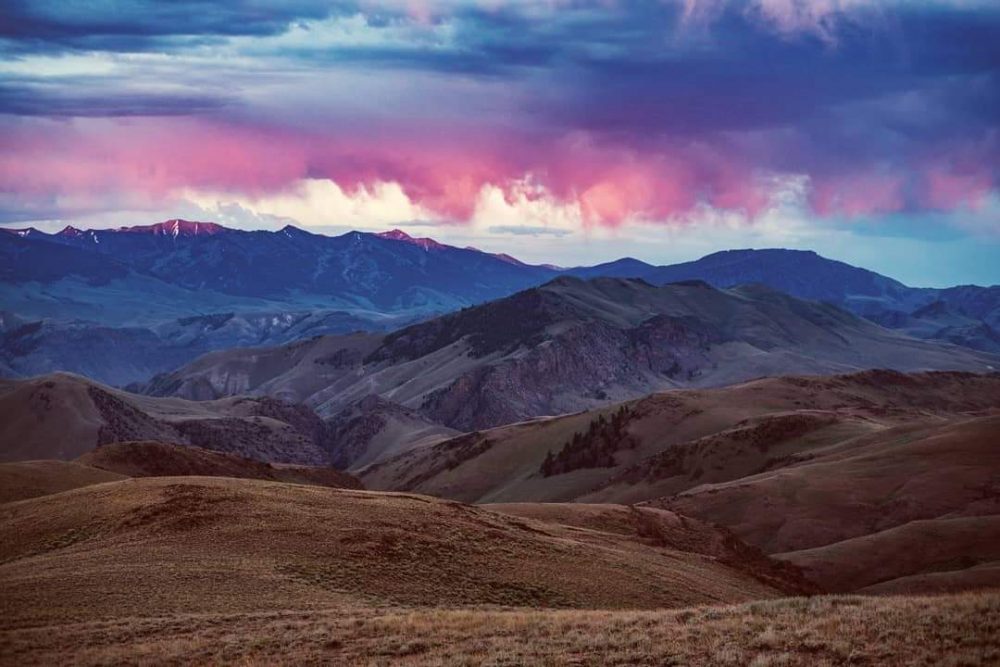
Glenn, Caryl, girls and cowhands from Alderspring.
For 26 years, handcrafting unparalleled flavor and wellness while regenerating wild landscapes. Wild Wellness Delivered.

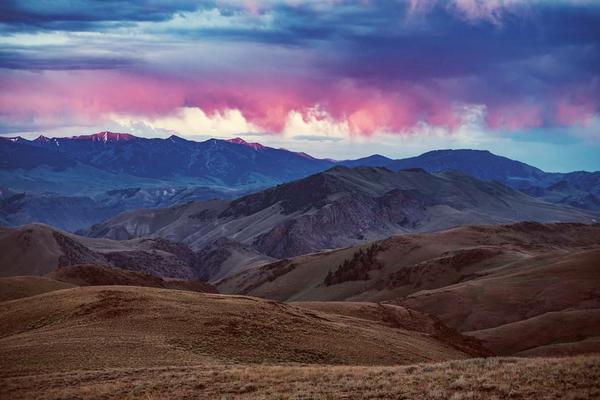


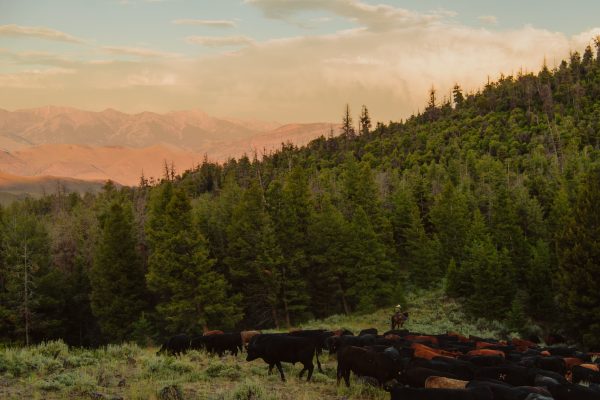

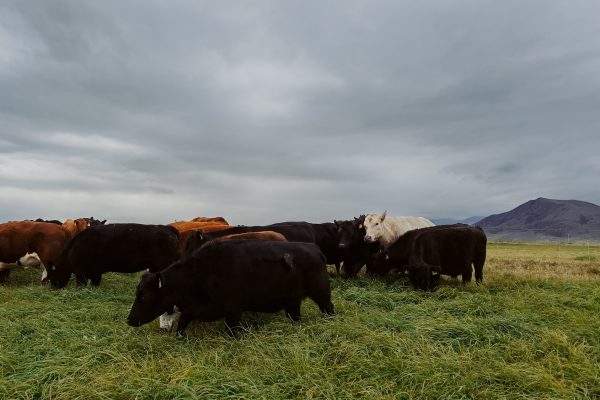
Leave a Reply